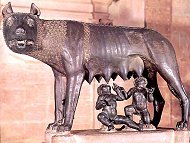She-Wolf and Romulus and RemusMuseum Label: Chiurazzi description: |
Sculpture info:
Wolf. Bronze. Height: 0.75 m; Length: 1.14 m
This statue is first mentioned at the very end of the tenth century as
being at the Lateran where executions were carried out --as they still were four centuries
later. In the late twelfth or early thirteenth century the body of the Wolf stood in the
portico at the entrance to the palace, represented as if stalking a bronze ram (which has
long disappeared), from whose mouth came a stream of water for washing one's hands: the
Wolf had apparently served the same purpose, the water coming from the teats, but by the
time of this description it had been broken off at the feet, which (with the pedestal)
probably remained in the open air in front of the palace. In 1471 the Wolf was
given to the Conservators of Rome by Pope Sixtus IV, and by 1509 the figures of Romulus
and Remus had been added. We know that by about 1536 it had been placed above the
entrance to the Palazzo dei Conservatori and that by 1544 (when the whole area was being
radically reconstructed by Michelangelo) it had been taken inside.
Until Winckelmann made the point almost in passing no one seems to have been aware
of the fact that the figures of Romulus and Remus were modern additions to the antique
statue, and this ignorance helped to confuse an already very confusing situation.
The earliest commentators were content to observe and admire, but by the middle of the
sixteenth century antiquarians felt the need to relate so portentous an image to some work
referred to in the literature of antiquity. Of the several possible references that could
be found two assumed special importance. Livy described how in the year 296 BC the aediles
Gnaius and Quintus Ogulnius, having denounced a group of usurers, made use of the fines
imposed upon them in order to place near the Rumanilis figtree 'the statues of the
Children, the Fathers of the City, beneath the mammals of a Wolf --the ambiguity of the
phrasing which left it unclear whether only the Children or the whole group of Wolf and
Children were then made troubled no one until the investigations of modern scholars.
In the early sixteenth century the artistic quality of the Wolf seems to have aroused
some genuine admiration, as can be seen both from the comments of the Venetian Ambassadors
in 1523 and of Aldrovandi some thirty years later and also from the existence of a number
of replicas and variants which appear to date from about then, including at least one
large bronze. But when copies of other antique statues were circulating widely in the
eighteenth century, the Wolf--though examined by every visitor to Rome--was clearly looked
upon as a relic, and not therefore an object to be reproduced.
Winckelmann thought that the Wolf was of Etruscan origin and indeed it is
catalogued in Helbig as probably Etruscan work made under the influence of Greek
sculpture, not in any way connected with Romulus and Remus, having perhaps served as a
sepulchral sentinel.
From: Taste and The Antique. The Lure of Classical Sculpture 1500 1900. Francis Haskell
and Nicholas Penny. 1981
Romulus and Remus
The story of the twins, sons of the god of War, Mars. In the legend Romulus and Remus are
orphaned when their mother, Silvia is imprisoned and the infants are cast into the Tiber
River. They are set ashore under a fig tree and found by a she wolf and a woodpecker,
animals that are sacred to Mars. The twins are fed and nursed by the animals, until
Faustulus, the king's herdsman finds them and raises them with his wife. They left home to
found their new kingdom on the shores of that same river where they had many years before
begun their legendary lives.
As children will often do, Romulus and Remus could agree upon neither the location of the
new city nor a name for it. It was during this strife that Romulus killed his twin, and
thereupon built the new settlement.
Lacking for inhabitants, the new king called upon outcasts from outlying communities to
come to his new homeland and to settle upon the Capitoline Hill where Romulus built a
sanctuary for misfits of other communities.
But, alas, Romulus soon discovered that his city was lacking for women, and he announced
that games were to be celebrated in honor of the god, Consus, and he thereby invited the
Latins and the Sabines to his celebration. It was during this event that the Romans lashed
out upon the virgins of the community and carried them away.
Romulus' reign was tainted with this story of the rape of the Sabine women, whose tribe,
under the leadership of Titus Tatius, allegedly infiltrated the new Latin lands and
battled with the inhabitants of Latium, thus forming a union of the two tribes early in
the history of ancient Rome.
During the ensuing war, the Sabine women prayed for peace, and they begged that the two
tribes unite and form one people, one nation. Unfortunately, the peace was short-lived,
and Titus Tatius, who was at this time co-reigning with Romulus, was killed in a
confrontation. Thus, Romulus continued his reign alone not only over the Latins but also
over the Sabines.
His 37-year reign as the first king of Rome ended when his father, Mars, carried him away
to heaven in a chariot of fire. Henceforth, Romulus demanded to be known as "Quirinus", the guardian god to the Romans.
